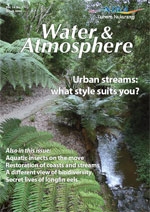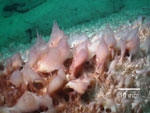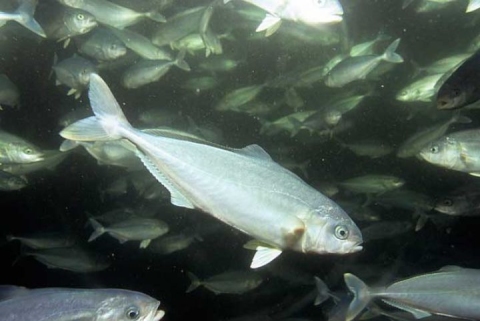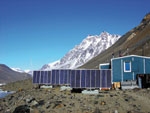PDF of this article (127 KB)

Going under the ice to measure microbial mats



The Dry Valley region of Southern Victoria Land, the largest ice-free region of Antarctica, is one of the coldest and driest deserts in the world. There are numerous meltwater lakes in this region thanks to two regional features, the Transantarctic Mountain Range that blocks the flow of ice from the polar plateau and eliminates precipitation, and the very low mean air temperature (–15 to –30 °C) that provides perennial ice cover, 3–6 m thick, to the lakes. Scientists have always been interested in the bacteria and microscopic algae inhabiting the lakes: they may offer insights into where and how life originated on earth, and where evidence of life – past or present – might occur on other planets on our solar system.
The ice cover creates extreme conditions for the lake inhabitants: it eliminates wind-mixing of the water column, intercepts most of the sun’s energy, and restricts gas exchange between the water and the atmosphere. One unique feature of these lakes that has developed as a consequence of ice cover is oxygen supersaturation of the water column, caused by the freezing of water at the underside of the ice cover and the photosynthesis of plankton. A second unusual feature is the occurrence of mats of cyanobacteria and microscopic algae, which cover much of the lake floors. A key question that has been asked for many years was whether these microbial mats are capable of using the very low ambient light to fix carbon and release oxygen into the bottom water, thereby recording in their annual layers past climate changes in the Dry Valleys.
With their laboratory and modelling experiments, NIWA scientists and their overseas collaborators had already produced evidence that these microbial mats actually photosynthesise. But photosynthesis had never been measured within the lakes, so the details of the photosynthetic activity of these mats remained speculative.
In November 2004, NIWA scientists Kay Vopel and Ian Hawes went under the ice to measure, for the first time, the rates of photosynthesis of microbial mats within one of the permanently ice-covered lakes of the McMurdo Dry Valleys. Using cutting-edge underwater micro-sensors, they were able to prove that, during the Antarctic summer, mats in Lake Hoare are capable of using extremely low ambient light to fix carbon and to release oxygen into the already supersaturated lake water. With their measurements, Vopel and Hawes have generated new insights into the physiology of photosynthesis under low-light and near-freezing conditions, and confirmed key aspects of photosynthesis previously based only on laboratory measurements. These findings greatly advance our understanding of the ecology of ice-covered polar lakes, and help illuminate the mats' secret geological record. This research will be published in the scientific journal Limnology and Oceanography later this year.
For further information, contact: Dr Kay Vopel, 0-7-859 1878, [email protected]
